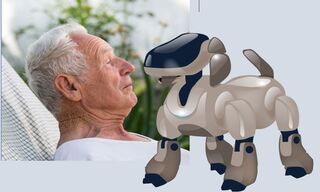Animal Behavior
Robotic Pet Therapy: Why Not?
Can robot pets offer relief from loneliness in a technical age?
Posted October 16, 2020

A robot is a machine that can be built to resemble a living creature — designed to move and respond to voice commands or by touch, and to perform complex tasks.
Most robots in use today don’t look much like living creatures. Instead, they perform laborious tasks in industrial settings. Robots build other machines, and with strength, dexterity, and endurance they can crank out products endlessly. In hospitals, humans guide robots to perform precision surgeries. And in nursing homes, the SECOM “My Spoon” feeds patients who need assistance while eating. This type of automation could eventually replace essential human contact and care, to the collective detriment.
Beyond robots for industrial or medical applications, there is increasing interest in SOCIAL robots.
So-called “intelligent” toys permeate the marketplace. From inexpensive toys to luxury programmable gadgets, these wheeled or multilegged, remote play-bots are fun and can spur young people to learn computer programming. Robot toys are often humanoid, with arms and legs like the “WowWee Biomorphic Robosapien” with karate moves and sound detection. Perhaps it is not surprising that toymakers also build robots to emulate our favorite pets. We now have automated hounds such as Sony’s robotic pup “Aibo,” or the Hasbro/Tiger Electronics “iDog” and variations including the iCat, iFish, and iTurtle. Collect them all for your robotic pet menagerie.
The merits of finding time to be playful were covered in a prior blog post called "Playfulness During a Pandemic." Psychologists acknowledge the many therapeutic benefits of play, from improved language development to increased physical and mental well-being. (1)
So-called therapy-dogs and support animals are widely popularized, and research bears this out. A meta-analysis of studies observed that “Animal Assisted Therapy” or AAT, showed moderate positive effects, improving outcomes with special groups for mental and physical disorders and improving overall behavioral and emotional status. (2) Living animal-assisted therapy seems to help, so why not try some robotic AAT?
States are beginning to experiment with providing robotic pets to elderly and dementia patients isolated by the quarantine. By interacting with a machine built to mimic a pet animal in appearance and behavior, it is likely that for some, the experience will be positive and therapeutic. These technology tools are helpful, but let’s not use robots as a substitute for living animals and human touch.
Companies such as “Joy for All” offer canine and feline robotic “animals” — and a movement has emerged to pair electronic companions for the elderly and other special populations. Those who are lonely and unable to care for a living pet could benefit from an electronic one. Compared with live pets, robot-pets do not require feeding, walking, and cleaning up after. During this pandemic, there is much isolation and loneliness, and so perhaps a robot pet can help!
In the future, robots might assist elderly patients with tasks such as getting up, walking, taking medication, or recording vital signs. A Japanese venture called RIKEN-TRI Center for Human-Interactive Robot Research has developed a nursing-care assistant named RIBA, a soft-to-the-touch robot who can lift a human patient. Will a soft robot lift us from bed or fetch the bedpan someday?
Get ready for the Robots! Offering companionship and more, robots require little more than an occasional recharge. At least we can’t catch COVID-19 from a robot (can we?). Hey, who deposited these batteries on the living room floor? FIDO!
References
(1) Fisher, E. P. (1992). The impact of play on development: A meta-analysis. Play & Culture, 5(2), 159–181.
Dankiw KA, Tsiros MD, Baldock KL, Kumar S (2020) The impacts of unstructured nature play on health in early childhood development: A systematic review. PLoS ONE 15(2): e0229006. https://doi.org/10.1371/journal.pone.0229006
(2) Nimer, Janelle & Lundahl, Brad. (2007). Animal-Assisted Therapy: A Meta-Analysis. Anthrozoos: A Multidisciplinary Journal of The Interactions of People & Animals. 20. 225-238. DOI:10.2752/089279307X224773.


